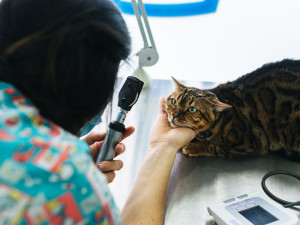What’s the Average Vet Bill for a Dog? Cost Breakdown and Tips
Part of being a great pet parent is preparing for your pup’s medical future. Here’s where to get started.

Share Article
In This Article:
The Main Factors Influencing Vet Bills Average Cost of Vet Bills Broken Down Comparison of Vet Bills by Location Ways to Manage Vet Expenses
Wouldn’t it be great if all our dogs needed was love? Unfortunately, being a pet parent also comes with financial responsibilities. The greatest of these costs for most people is veterinary care.
Several factors contribute to veterinary bills. Some pet parents just get lucky: Their dog lives a long life with no illnesses, and vet costs are minimal. That’s the exception, not the rule. Most dogs become ill from time to time — ears, eyes, teeth, tummies. The cost of caring for those illnesses can add up to a significant sum.
That amount is based on several variables, and understanding them can help pet parents prepare for the financial side of sharing their lives with a dog. This article breaks down the average cost of veterinary bills, explains the factors that influence these costs, and offers strategies for managing expenses effectively.
How much do you spend on your pet per year?

The main factors influencing vet bills
Vet care isn’t a one-size-fits-all thing. Several factors influence how much you are going to pay for your pup’s veterinary service.
Breed and size of your dog
The breed and size of your dog greatly impact veterinary costs. As you may imagine, the larger the dog, the more medication required. That’s also true for anesthesia and certain equipment. Their breed can also make a difference. Certain breeds are more likely to get certain hereditary conditions.
Here are a few examples:
Bulldogs: Prone to respiratory and skin conditions
German Shepherds: Prone to hip dysplasia
Dachshunds: Prone to intervertebral disc disease (IVDD)
Each of those conditions comes with different fees, and all of them will incur more expenses than if you had a dog without a hereditary condition.
Location
You may be surprised to learn that where you live plays a significant role when it comes to your vet bill. Urban areas have a higher cost of living and veterinary services that are significantly more expensive than those in rural areas. A routine checkup in New York City may cost twice as much as one in a rural town in the Midwest.
Age and health condition
If your dog is approaching their senior years or has a chronic medical condition that requires repeated visits, the cost is going to be higher than a routine visit. They may require more advanced specialized diagnostic tests and treatments, as well as more frequent visits. The costs of ultrasounds, X-rays, and laboratory tests can add up.
Type of visit (routine vs. emergency)
Routine visits for your dog may be easily affordable, but are you prepared for emergencies? These can include advanced diagnostics, hospitalizations, and sophisticated treatments. For example, a routine dental cleaning may cost $300, but an emergency tooth extraction could exceed $1,200.
These days, corporations have taken over many formerly private clinics. Corporate chains such as Banfield or VCA may offer standardized pricing and wellness plans, which can be more affordable than those of smaller, private clinics, which have widely varying prices due to factors such as staff costs, overhead, and service prices.
Average cost of vet bills broken down
Understanding the cost of each type of veterinary visit can help pet parents plan. The following costs are estimates only and will vary.
Routine check-ups and vaccinations
A routine vet visit usually includes a physical exam, vaccinations, and parasite prevention.
Annual exam: $50 to $100
Vaccines (core set): $75 to $150
Heartworm test: $35 to $75
Fecal exam: $25 to $50
Overall, a yearly check-up with basic testing and vaccines can cost between $200 and $400.
Emergency visits
Emergency visits are often the most expensive type of care. The cost will vary depending on the dog’s illness or injury, and the amount of diagnostic testing and treatment involved.
Emergency exam fee: $100 to $200
X-rays: $150 to $250
Bloodwork: $100 to $200
Hospitalization: $500 to $1,500
Overnight care (per night): $300 to $800
Total emergency costs can range from $500 to more than $2,000, with sometimes higher costs for critical surgeries or intensive care.
Surgery and specialized treatments
Surgical procedures vary widely in cost.
Spay/neuter: $200 to $500
Tumor removal: $500 to $1,500
TPLO (for torn ACL): $2,000 to $5,000
Dental surgery: $800 to $2,000
MRI or CT scan: $1,500 to $3,000
Specialist visits, such as those with veterinary oncologists, neurologists, ophthalmologists, or cardiologists, can run $300 to $600 per consultation alone.
Dental care
Dental disease is something every dog will need at some point. If you take care of your dog’s teeth regularly, including home care, your pup may not need extractions. If extractions are necessary, the cost can be significantly higher.
Routine dental cleaning: $300 to $700
Tooth extraction (per tooth): $100 to $300
Advanced dental surgery: $1,000 to $2,500
Preventive dental care can reduce long-term costs, while neglecting oral health may lead to expensive corrective procedures.
Prescription visits
Chronic conditions such as allergies, arthritis, epilepsy, diabetes, or hyperthyroidism often require lifelong medications. Costs include:
Exam and lab work: $75 to $250 per visit
Monthly medication: $20 to $100, depending on the condition and drug
Monitoring tests (annually, semi-annually, or more often): $100 to $300
The annual cost for managing a chronic condition may range from $300 to more than $1,200.
Comparison of vet costs by location
Where you live can significantly impact the cost of veterinary care. Here’s a closer look.
Urban vs. rural
In urban areas, higher operating costs, rent, and salaries contribute to higher fees.
Urban exam fee: $80 to $150
Rural exam fee: $40 to $90
Surgery and emergency services may also be more expensive in cities due to more advanced equipment and specialized expertise.
US vs. international
Veterinary care in the U.S. is generally more expensive than in many other countries. Here are some yearly estimates, per dog.
United States: $400 to $700
Canada: Slightly lower at CAN $300 to $600
UK: £300 to £600 (not covered by the National Health Service)
Australia: AUD $300 to $800, similar to US rates
Some countries offer subsidized or nonprofit veterinary services that reduce pet healthcare costs, while others lack the same level of access to advanced diagnostics.
Ways to manage vet expenses
Fortunately, there are various ways pet parents can manage veterinary costs and keep them to a minimum.
Pet insurance
Pet insurance is increasingly popular as veterinary costs rise and more competitive companies offer insurance, keeping premiums to a minimum.
Plans usually cover:
Accidents and emergencies
Illnesses and surgeries
Some preventive care (if included in the plan)
Monthly premiums vary by a dog’s breed, age, and location, ranging from $30 to $90 monthly. Although pet insurance may not cover preexisting conditions, it can offset thousands of dollars in emergency or surgical bills.
Popular providers include:
Trupanion
Healthy Paws
Nationwide
Embrace
ASPCA Pet Health Insurance
Preventative care tips
Nothing sets you up for lower vet bills like preventative care, because avoiding an illness is much cheaper than treating it. Here are some preventative-care tips for your pup.
Maintain regular checkups to catch problems early.
Stay up-to-date on vaccinations and parasite prevention.
Care for your pup’s teeth at home by brushing, offering dental chews, and putting water additives in the water.
Feed them a high-quality, well-balanced diet.
Exercise them regularly so they maintain a healthy weight.
By being proactive, you can help prevent or manage many costly conditions.
Budgeting for routine expenses
Some pet parents would rather create a pet emergency-savings account in preparation for emergencies than enroll in pet insurance. Creating a pet health fund or savings account is a smart way to avoid a sudden financial burden. Here are a few ways to start.
Set aside $30 to $50 per month per pet.
Utilize pet-specific savings apps or set up automatic transfers.
Anticipate larger annual costs, such as dental expenses or vaccines, by breaking them down into monthly contributions.
You can also enroll in a wellness plan through many of the corporate veterinary hospitals, which allows you to pay a monthly fee for a package that includes exams, vaccines, blood work, and even dental care.
Bottom line
Several factors influence the cost of veterinary bills: the types of care, your dog’s age and breed, the location of the hospital, and the type of hospital.
You never know when an emergency may come along, and some of those are very costly.
It’s important to plan for those times by putting money into a pet savings account, taking out pet insurance, and practicing good preventative care.
References
Bir, Courtney, et al. “Familiarity and Use of Veterinary Services by US Resident Dog and Cat Owners.” Animals: An Open Access Journal from MDPI, vol. 10, no. 3, 13 Mar. 2020, www.ncbi.nlm.nih.gov/pmc/articles/PMC7143178/#:~:text=According%20to%20the%202017%E2%80%932018, https://doi.org/10.3390/ani10030483opens in new tab.
Lue, Todd W., et al. “Impact of the Owner-Pet and Client-Veterinarian Bond on the Care That Pets Receive.” Journal of the American Veterinary Medical Association, vol. 232, no. 4, 15 Feb. 2008, pp. 531–540, avmajournals.avma.org/view/journals/javma/232/4/javma.232.4.531.xmlopens in new tab, https://doi.org/10.2460/javma.232.4.531opens in new tab.
Williams, Angelica, et al. “The Impact of Pet Health Insurance on Dog Owners’ Spending for Veterinary Services.” Animals, vol. 10, no. 7, 9 July 2020, p. 1162, content.ebscohost.com/ContentServer.asp?EbscoContent=dGJyMMTo50Sep7c4y9fwOLCmsEmeprFSsay4S7OWxWXS&ContentCustomer=dGJyMPGqt0uyrLVRuePfgeyx43zx1%2B6B&T=P&P=AN&S=R&D=a9h&K=144875102, https://doi.org/10.3390/ani10071162opens in new tab.

Dr. Shelby Neely, DVM
Dr. Shelby Neely is a freelance writer and veterinarian who graduated from the University of Pennsylvania School of Veterinary Medicine and has practiced veterinary medicine for 30 years, specializing in small animals. Her work has appeared in Allivet, AsktheCatDoctor, WhiskerDocs, Ask the Cat Doctor Radio, Ask the Cat Doctor TV, and numerous other websites, brochures, newsletters, newspapers, and ebooks. In her spare time, Dr. Neely likes to spend time with her three children, two grandchildren, three cats, two grand-cats, and five grand-dogs.
Related articles
How Much Will Your Dog Cost You in a Lifetime?
Our best friends are worth their weight in gold. But—it’s no big deal, just wondering—how much gold, exactly?
![shiba inu snuggling on couch with woman]()
Money Talks: The Dollars of Dog Parenthood
We crunched some numbers and yup, they’re worth every penny.
Why Do I Have to Pay an Adoption Fee?
If you’re helping out a homeless pet, shouldn’t that be worth a freebie? The reality is, it costs a lot of money to care for shelter animals and to keep a shelter clean and safe.
How Much Does Dog Teeth Cleaning Cost?
Real talk: Your pup’s dental health is a necessary expense.
![Dalmatian mix breed dog is playing with a dog toy on a soft surface]()
Digging into the Fine Print of Pet Insurance
Everything you need to know to understand pet insurance plans.







